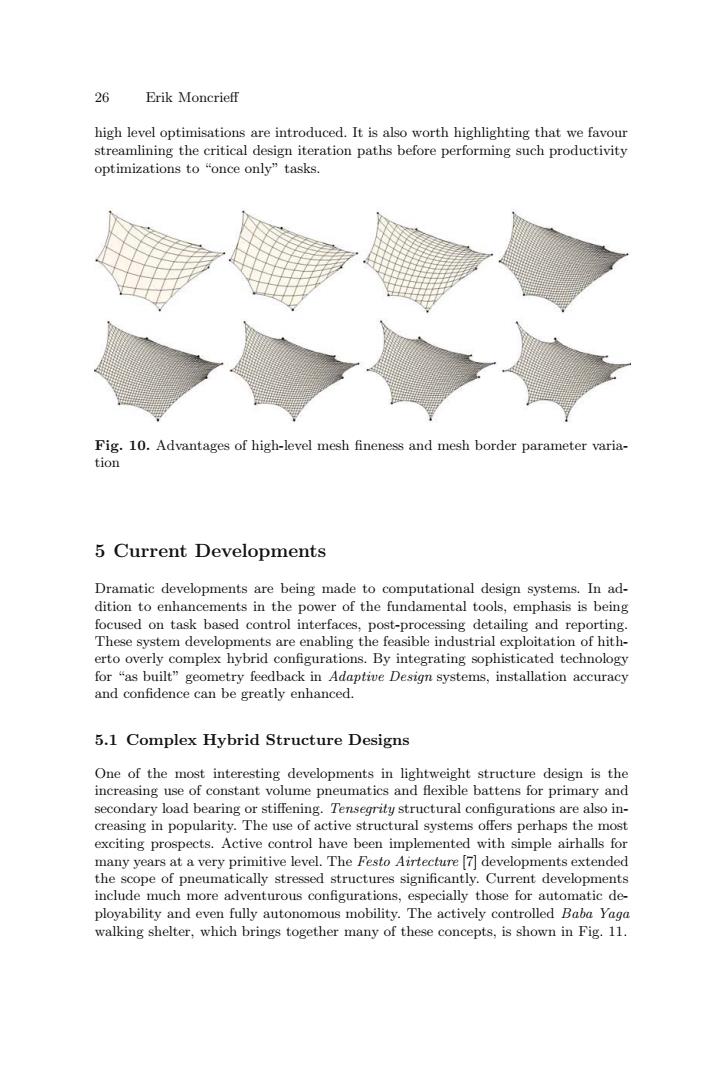正在加载图片...

26 Erik Moncrieff high level optimisations are introduced.It is also worth highlighting that we favour streamlining the critical design iteration paths before performing such productivity optimizations to "once only"tasks. Fig.10.Advantages of high-level mesh fineness and mesh border parameter varia- tion 5 Current Developments Dramatic developments are being made to computational design systems.In ad- dition to enhancements in the power of the fundamental tools,emphasis is being focused on task based control interfaces,post-processing detailing and reporting. These system developments are enabling the feasible industrial exploitation of hith- erto overly complex hybrid configurations.By integrating sophisticated technology for "as built"geometry feedback in Adaptive Design systems,installation accuracy and confidence can be greatly enhanced. 5.1 Complex Hybrid Structure Designs One of the most interesting developments in lightweight structure design is the increasing use of constant volume pneumatics and flexible battens for primary and secondary load bearing or stiffening.Tensegrity structural configurations are also in- creasing in popularity.The use of active structural systems offers perhaps the most exciting prospects.Active control have been implemented with simple airhalls for many years at a very primitive level.The Festo Airtecture [7]developments extended the scope of pneumatically stressed structures significantly.Current developments include much more adventurous configurations,especially those for automatic de- ployability and even fully autonomous mobility.The actively controlled Baba Yaga walking shelter,which brings together many of these concepts,is shown in Fig.11.26 Erik Moncrieff high level optimisations are introduced. It is also worth highlighting that we favour streamlining the critical design iteration paths before performing such productivity optimizations to “once only” tasks. Fig. 10. Advantages of high-level mesh fineness and mesh border parameter variation 5 Current Developments Dramatic developments are being made to computational design systems. In addition to enhancements in the power of the fundamental tools, emphasis is being focused on task based control interfaces, post-processing detailing and reporting. These system developments are enabling the feasible industrial exploitation of hitherto overly complex hybrid configurations. By integrating sophisticated technology for “as built” geometry feedback in Adaptive Design systems, installation accuracy and confidence can be greatly enhanced. 5.1 Complex Hybrid Structure Designs One of the most interesting developments in lightweight structure design is the increasing use of constant volume pneumatics and flexible battens for primary and secondary load bearing or stiffening. Tensegrity structural configurations are also increasing in popularity. The use of active structural systems offers perhaps the most exciting prospects. Active control have been implemented with simple airhalls for many years at a very primitive level. The Festo Airtecture [7] developments extended the scope of pneumatically stressed structures significantly. Current developments include much more adventurous configurations, especially those for automatic deployability and even fully autonomous mobility. The actively controlled Baba Yaga walking shelter, which brings together many of these concepts, is shown in Fig. 11